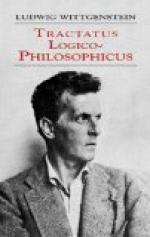5.502 So instead of ‘(-----T)(E, ....)’, I write ‘N(E)’. N(E) is the negation of all the values of the propositional variable E.
5.503 It is obvious that we can easily express how propositions may be constructed with this operation, and how they may not be constructed with it; so it must be possible to find an exact expression for this.
5.51 If E has only one value, then N(E) = Pp (not p); if it has two values, then N(E) = Pp . Pq. (neither p nor g).
5.511 How can logic—all-embracing logic, which mirrors the world—use such peculiar crotchets and contrivances? Only because they are all connected with one another in an infinitely fine network, the great mirror.
5.512 ‘Pp’ is true if ‘p’ is false. Therefore, in the proposition ‘Pp’, when it is true, ‘p’ is a false proposition. How then can the stroke ‘P’ make it agree with reality? But in ‘Pp’ it is not ‘P’ that negates, it is rather what is common to all the signs of this notation that negate p. That is to say the common rule that governs the construction of ‘Pp’, ‘PPPp’, ‘Pp C Pp’, ‘Pp . Pp’, etc. etc. (ad inf.). And this common factor mirrors negation.
5.513 We might say that what is common to all symbols that affirm both p and q is the proposition ‘p . q’; and that what is common to all symbols that affirm either p or q is the proposition ‘p C q’. And similarly we can say that two propositions are opposed to one another if they have nothing in common with one another, and that every proposition has only one negative, since there is only one proposition that lies completely outside it. Thus in Russell’s notation too it is manifest that ‘q : p C Pp’ says the same thing as ‘q’, that ‘p C Pq’ says nothing.
5.514 Once a notation has been established, there will be in it a rule governing the construction of all propositions that negate p, a rule governing the construction of all propositions that affirm p, and a rule governing the construction of all propositions that affirm p or q; and so on. These rules are equivalent to the symbols; and in them their sense is mirrored.
5.515 It must be manifest in our symbols that it can only be propositions that are combined with one another by ‘C’, ‘.’, etc. And this is indeed the case, since the symbol in ‘p’ and ‘q’ itself presupposes ‘C’, ‘P’, etc. If the sign ‘p’ in ‘p C q’ does not stand for a complex sign, then it cannot have sense by itself: but in that case the signs ‘p C p’, ‘p . p’, etc., which have the same sense as p, must also lack sense. But if ‘p C p’ has no sense, then ‘p C q’ cannot have a sense either.
5.5151 Must the sign of a negative proposition be constructed with that of the positive proposition? Why should it not be possible to express a negative proposition by means of a negative fact? (E.g. suppose that “a’ does not stand in a certain relation to ‘b’; then this might be used to say that aRb was not the case.) But really even in this case the negative proposition is constructed by an indirect use of the positive. The positive proposition necessarily presupposes the existence of the negative proposition and vice versa.




